Did you know that choy sum, a popular leafy green in Chinese cuisine, is packed with essential nutrients that can benefit your health in numerous ways? This vibrant vegetable, also known as choi sum or cai xin, offers a delightful combination of flavors and textures that will elevate your culinary creations. From its mild and slightly sweet taste to its impressive array of vitamins and minerals, choy sum is a must-try Asian green that can add both nutrition and excitement to your meals.
Key Takeaways:
- Choy sum is a leafy green in Chinese cuisine that resembles a cross between broccoli rabe and bok choy.
- It is rich in essential nutrients such as Vitamin C, Vitamin A, protein, calcium, and iron.
- Choy sum can be used in stir-fries, vegetable side dishes, and as a topping for protein sources like tofu.
- Its mild and slightly sweet flavor makes it a versatile ingredient in various cooking methods.
- Include choy sum in your diet for its numerous health benefits and to explore the diverse flavors of Asian greens.
What is Choy Sum?
Choy sum, scientifically known as Brassica rapa var. parachinensis, is a leafy green vegetable that is commonly used in Chinese cuisine. It belongs to the Brassica family, which includes other popular Asian greens like bok choy and mustard greens.
Choy sum has long, thin stems with tender leaves and tiny yellow flowers. It has a mild and slightly sweet taste, similar to a cross between broccoli rabe and bok choy. The texture of choy sum is crisp and tender, making it a versatile vegetable for various cooking methods.
Whether sautéed, stir-fried, or steamed, choy sum adds a delightful crunch and subtle flavor to dishes. Its vibrant green color not only enhances the visual appeal of a meal but also indicates its nutritional value. Choy sum is a rich source of vitamins and minerals, making it a healthy choice for those looking to incorporate more greens into their diet.
Health Benefits of Choy Sum
Choy sum is packed with essential nutrients that contribute to overall health and wellbeing. It is a good source of Vitamin C, which supports immune function and collagen production. Additionally, choy sum contains Vitamin A, which is important for vision health and skin health. It is also low in calories and fat, making it a great choice for weight management.
Cooking with Choy Sum
Choy sum is a versatile vegetable that can be cooked in various ways to suit different taste preferences. One popular method is stir-frying, which allows the vegetable to retain its crispness and vibrant color. It can also be blanched and served as a side dish or added to soups and stews. Choy sum pairs well with tofu, chicken, or shrimp, adding a nutritious element to your favorite dishes.
| Dish | Preparation Method |
|---|---|
| Stir-Fried Choy Sum | Sauté the choy sum with garlic, ginger, and soy sauce for a quick and flavorful side dish. |
| Choy Sum Soup | Add blanched choy sum to a savory broth for a nutritious and comforting soup. |
| Choy Sum Rice Bowl | Serve stir-fried choy sum over steamed rice with your choice of protein for a satisfying meal. |
“Choy sum’s delicate flavor and crisp texture make it a favorite ingredient in Chinese cuisine. It adds a fresh and vibrant element to dishes, elevating their taste and appearance.” – Chef Michael Lee
Choy sum not only adds a nutritional boost to meals but also brings a touch of authenticity to your Asian-inspired recipes. Whether you’re a seasoned chef or a kitchen enthusiast, choy sum opens up a world of culinary possibilities.
Health Benefits of Choy Sum
Choy sum is not only delicious but also highly nutritious. It is a vibrant green leafy vegetable that offers a wide range of health benefits. Let’s take a closer look at why choy sum is a valuable addition to your diet:
Vitamin C for Immune Function and Collagen Production
Choy sum is a rich source of Vitamin C, a powerful antioxidant that plays a crucial role in supporting a healthy immune system. Vitamin C also aids in collagen production, promoting healthy skin, tissues, and bones.
Vitamin A for Vision and Skin Health
In addition to Vitamin C, choy sum contains Vitamin A, an essential nutrient for maintaining good vision health and promoting healthy skin. Vitamin A helps protect the eyes from age-related macular degeneration and supports the maintenance of clear, glowing skin.
Low in Calories and Fat for Weight Management
If you’re watching your calorie intake or aiming to maintain a healthy weight, choy sum is an excellent choice. With its low-calorie content and minimal fat, choy sum allows you to enjoy a filling and nutritious meal without compromising your calorie goals.
Dietary Fiber for Digestive Health
Choy sum is a good source of dietary fiber, which is essential for maintaining a healthy digestive system. Fiber adds bulk to your diet, promoting regular bowel movements, preventing constipation, and supporting overall gut health.
Calcium and Iron for Bone and Blood Health
Choy sum is also rich in calcium and iron, two vital minerals that promote bone health and ensure proper oxygen transport in the body. Calcium contributes to strong bones and teeth while iron helps prevent iron-deficiency anemia and supports proper blood cell production.
Summary:
Choy sum, with its abundance of vitamins, minerals, and dietary fiber, is a nutritious green vegetable that offers numerous health benefits. Incorporating choy sum into your diet can help boost your immune system, improve vision health, promote weight management, support digestive health, and enhance bone and blood health.
Cooking with Choy Sum
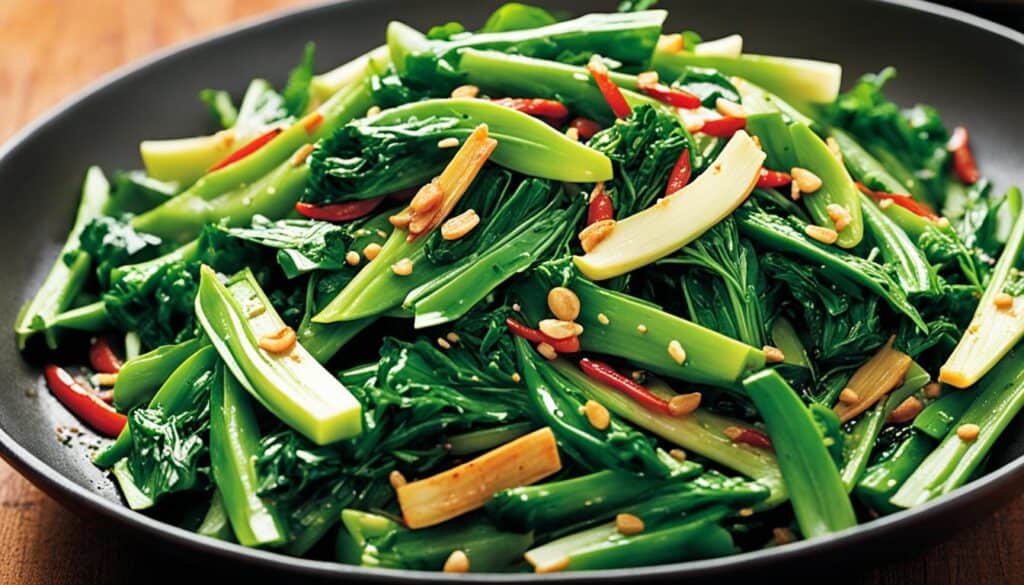
Choy sum is a versatile vegetable that can be cooked in various ways. One popular method is stir-frying. Simply heat some oil in a pan, add minced garlic and ginger, and then toss in the choy sum. Cook for a few minutes until the leaves are wilted and the stems are tender-crisp. Season with soy sauce or rice wine for added flavor. Choy sum can also be blanched and served as a side dish or added to soups and stews.
Here is a simple recipe for a delicious choy sum stir-fry:
- Heat 2 tablespoons of vegetable oil in a large skillet over medium-high heat.
- Add 3 cloves of minced garlic and 1 tablespoon of minced ginger to the skillet. Cook for 1 minute until fragrant.
- Add 1 bunch of choy sum, trimmed and cut into bite-sized pieces, to the skillet. Cook for 3-4 minutes until wilted.
- Season with 2 tablespoons of soy sauce, 1 tablespoon of oyster sauce, and a pinch of red pepper flakes. Stir well to coat the choy sum.
- Remove from heat and serve hot. Enjoy your flavorful and nutritious choy sum stir-fry!
Choy sum also pairs well with tofu, chicken, or shrimp in stir-fries. You can experiment with different seasonings and sauces to create your own unique choy sum dishes.
Choy Sum Stir-Fry Recipe
| Ingredients | Instructions |
|---|---|
|
|
Choy sum stir-fry is a delicious and healthy side dish that can be prepared in no time. Its vibrant green color and tender-crisp texture make it visually appealing and enjoyable to eat. Whether you’re a vegetarian looking for a nutritious meal or simply want to incorporate more leafy greens into your diet, choy sum stir-fry is a perfect choice. Try this recipe today and savor the flavors of this delightful Asian green.
Other Asian Green Varieties
When it comes to Asian greens, choy sum is just the beginning. There are a variety of other delicious options that you can incorporate into your culinary adventures. Let’s explore some popular Asian green varieties:
Chinese Cabbage/Napa Cabbage
Chinese cabbage, also known as napa cabbage, is a staple in Chinese cuisine. With its mild flavor and tender texture, it is commonly used in stir-fries and hot pot dishes. This versatile cabbage is packed with nutrients and adds a delightful crunch to any recipe.
Bok Choy
Bok choy is another leafy green that is widely used in Asian cuisine. It has a slightly sweet and earthy taste, making it a popular choice for stir-fries, soups, and even salads. Bok choy’s tender leaves and crisp stalks bring a refreshing texture to any dish.
Mustard Greens
If you’re looking for a vegetable with a bold and peppery flavor, mustard greens are perfect for you. These greens can be enjoyed raw in salads, sautéed as a side dish, or even added to soups and stews for an extra kick of flavor.
Mizuna
Mizuna is a Japanese leafy green that adds a unique and slightly spicy taste to dishes. It is often used in salads, stir-fries, and even as a garnish. Mizuna’s delicate leaves and vibrant green color make it a visually appealing addition to any plate.
Tatsoi
Tatsoi, also known as spoon mustard or spinach mustard, is a versatile green that can be eaten raw or cooked. It has a mild and slightly sweet taste, similar to bok choy. Tatsoi’s dark green leaves and tender stems are perfect for salads, stir-fries, and even sautéing as a vegetable side dish.
Pea Shoots
Pea shoots are the young, tender leaves of pea plants. They have a delicate flavor and a crisp texture, adding a fresh and vibrant element to any dish. Pea shoots can be enjoyed in salads, stir-fries, or even lightly sautéed as a side dish.
Each of these Asian green varieties brings its own distinct flavor and texture to your meals. Experiment with different combinations and recipes to discover your favorite way to enjoy these nutritious greens.
How to Choose and Store Choy Sum
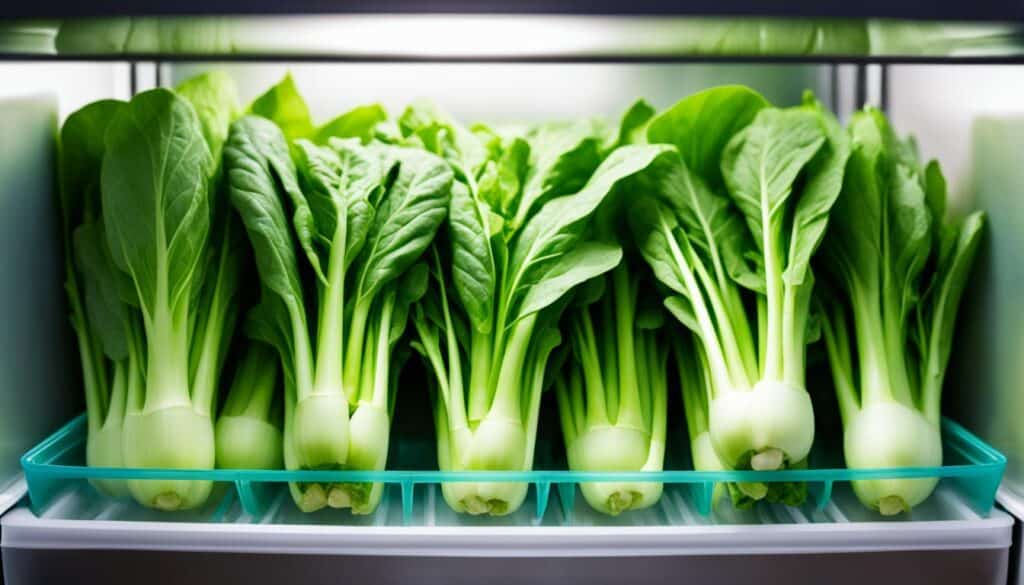
When it comes to selecting choy sum, freshness is key. Look for vibrant green leaves and firm stems, avoiding any yellowing or wilting leaves. This ensures that you are getting the best quality choy sum for your dishes.
Once you have chosen your choy sum, it is best to use it as soon as possible to preserve its optimal freshness and flavor. If you need to store it for a few days, follow these simple steps:
- Wrap the choy sum in a damp paper towel to keep it hydrated and prevent wilting.
- Place the wrapped choy sum in a plastic bag, removing as much air as possible before sealing.
- Store the bag of choy sum in the refrigerator, preferably in the crisper drawer.
By following these storage guidelines, your choy sum should stay fresh for up to 5 days, allowing you to enjoy its tasty goodness whenever you’re ready to cook.
Prior to cooking, it is important to give your choy sum a thorough rinse to remove any dirt or debris. This ensures that you are starting with clean and hygienic greens for your culinary creations.
Remember, choy sum is a delicate and nutrient-rich vegetable, so proper storage and handling are key to maintaining its quality and taste.
Pro tip: If you have a surplus of choy sum and want to extend its shelf life, blanch it briefly in boiling water for a minute or two, then plunge it into an ice bath to stop the cooking process. Drain the choy sum well and store it in a freezer-safe bag or container. Frozen choy sum can be used in soups or stir-fries, but keep in mind that the texture may change slightly after freezing.
With these storage tips in mind, you can ensure that your choy sum stays fresh and crisp, ready to add a burst of flavor and nutrition to your favorite Asian-inspired dishes.
Choy Sum in Traditional Chinese Cuisine
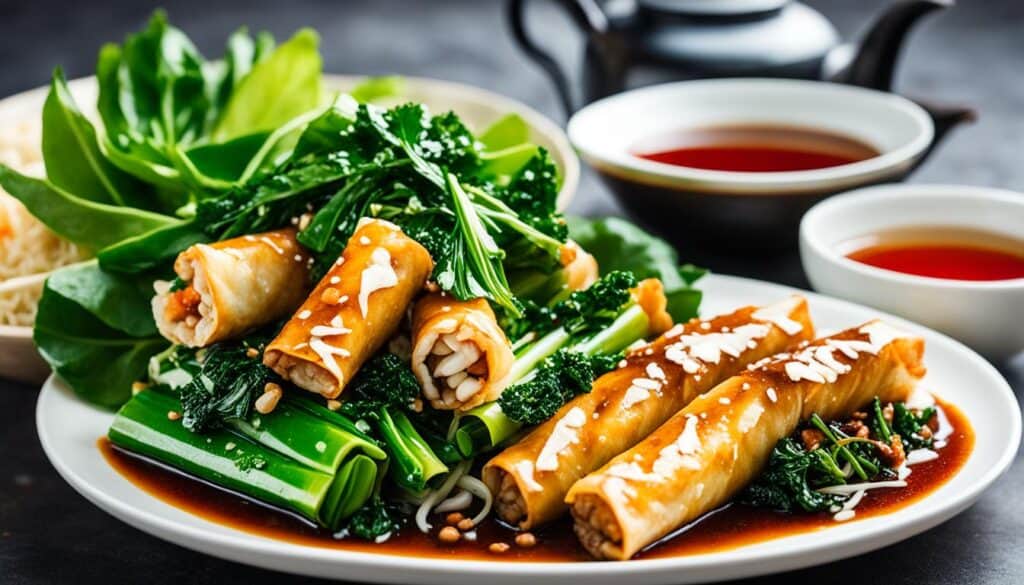
Choy sum has been an integral part of traditional Chinese cuisine for centuries. Its versatile nature allows it to be utilized in a wide variety of dishes, ranging from simple stir-fries to elaborate hot pot creations. In Cantonese cuisine, choy sum is particularly popular in vegetarian dishes, where its vibrant green leaves and tender texture contribute to the overall visual and flavorful appeal of the meal. Additionally, choy sum is often combined with seafood or meat, adding depth and balance to the dish.
“Choy sum brings a subtle but delightful flavor to traditional Chinese dishes, complementing other ingredients and creating a harmonious blend of flavors.” – Chef Li Mei
One of the reasons choy sum is highly valued in Chinese cuisine is its tender texture, which makes it an ideal choice for a variety of cooking methods. Whether stir-fried, steamed, or added to soups, choy sum retains its crispness and bright color. Its mild flavor allows it to enhance the taste of the dish without overpowering other ingredients, making it a versatile and adaptable vegetable in traditional Chinese cooking.
The Significance of Choy Sum in Chinese Culture
Choy sum holds a special place in Chinese culture, particularly during festive occasions such as Lunar New Year dinners. Its vibrant green color symbolizes vitality and prosperity, making it an auspicious ingredient to include in celebratory meals. Choy sum is often served as part of a larger spread of dishes, representing abundance and good fortune for the coming year.
The cultural significance of choy sum extends beyond its symbolic value. It is deeply ingrained in the culinary traditions of various Chinese regions, each incorporating the vegetable into their distinct local cuisines. From the delicate flavors of Cantonese cuisine to the bold and spicy dishes of Sichuan cuisine, choy sum adds a touch of freshness and nutrition to traditional Chinese fare.
Choy Sum Recipes from Different Chinese Regions
| Region | Choy Sum Dish |
|---|---|
| Cantonese Cuisine | Stir-fried Choy Sum with Garlic |
| Sichuan Cuisine | Spicy Choy Sum and Tofu Stir-fry |
| Hunan Cuisine | Choy Sum in Hot Garlic Sauce |
These regional dishes showcase the versatility of choy sum and how it can be incorporated into different flavors and spice levels. Whether you prefer a mild and aromatic stir-fry or a fiery and bold dish, there is a choy sum recipe to suit every palate.
Choy sum continues to be a beloved ingredient in traditional Chinese cuisine, providing a nutritious and flavorful addition to a wide range of dishes. Its cultural significance and versatile nature make it a staple in Chinese vegetable dishes, embodying the essence of traditional Chinese cooking.
Choy Sum in Modern Cuisine
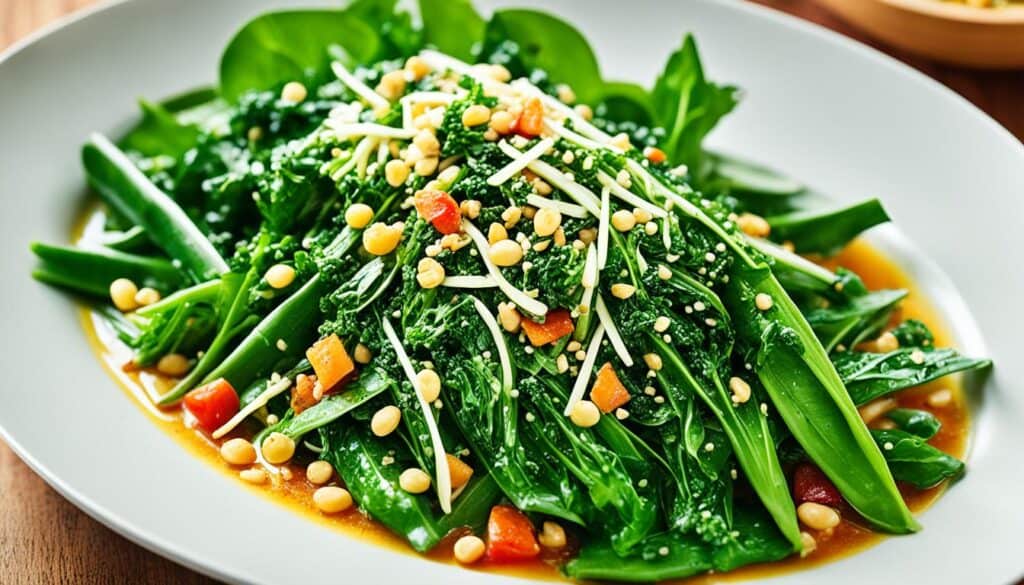
Choy sum is not only limited to traditional Chinese cuisine but has also made its way into modern dishes and fusion creations. Chefs around the world are incorporating choy sum into their culinary creations, combining it with flavors and ingredients from different cuisines.
Choy sum’s versatility and mild flavor make it a great addition to a wide range of contemporary recipes. It can be used in pasta dishes, adding a vibrant and nutritious element to your favorite noodles. Try tossing choy sum with garlic-infused olive oil, cherry tomatoes, and Parmesan cheese for a simple yet flavorful pasta dish.
Salads also benefit from the addition of choy sum. Its tender leaves and crisp stems can bring a fresh and unique element to your salad bowl. Pair it with other fresh vegetables like cherry tomatoes, cucumber, and radishes, and dress with a light vinaigrette for a refreshing and nutritious meal.
Fusion dishes are another exciting realm where choy sum shines. Incorporate it into wraps or tacos, along with ingredients like grilled chicken or tofu, avocado, and a zesty sauce. This combination of flavors and textures creates a delightful fusion experience that merges the best of different culinary traditions.
“Choy sum’s versatility allows me to experiment with diverse flavors and textures. It adds a vibrant touch to my dishes and keeps my customers coming back for more.” – Chef Julia Smith
Choy sum can even be used as a topping for pizzas, providing a unique twist to a beloved classic. Combine it with other toppings like roasted garlic, mozzarella cheese, and chili flakes for a fusion masterpiece that will satisfy your taste buds.
Embrace the culinary possibilities of choy sum in contemporary recipes and fusion dishes, and let your creativity shine through. With its mild flavor and nutrient-packed profile, choy sum is the perfect ingredient to elevate your modern culinary creations.
Conclusion
Choy sum is an incredibly versatile and nutritious leafy green vegetable that has gained popularity in Chinese cuisine. Its mild flavor and tender texture make it a perfect addition to a variety of dishes, including stir-fries, soups, and vegetable side dishes. With its high content of vitamins, minerals, and dietary fiber, choy sum offers an array of health benefits that contribute to overall well-being.
Whether you are a fan of traditional Chinese cuisine or love to experiment with new flavors, choy sum should definitely be on your cooking radar. This Asian green vegetable adds a delightful touch of freshness and nutrition to your meals. From its vibrant, leafy greens to its tender, crispy stems, choy sum provides a unique culinary experience.
Make choy sum a staple in your kitchen and elevate your cooking repertoire with this nutritious leafy green. Incorporating choy sum into your meals opens up a world of gastronomic possibilities. So, get adventurous and enjoy the delightful flavors and health benefits that choy sum and other Asian greens have to offer.

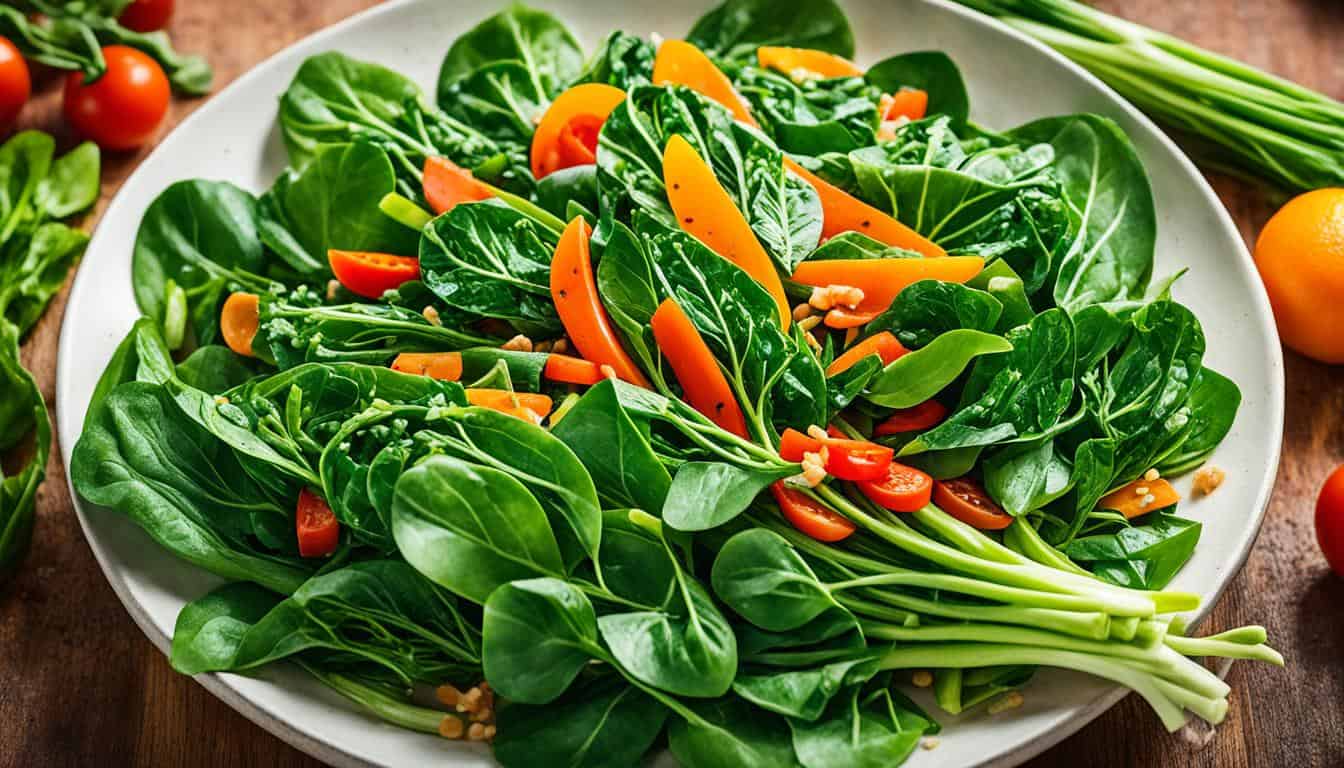



Leave a Reply